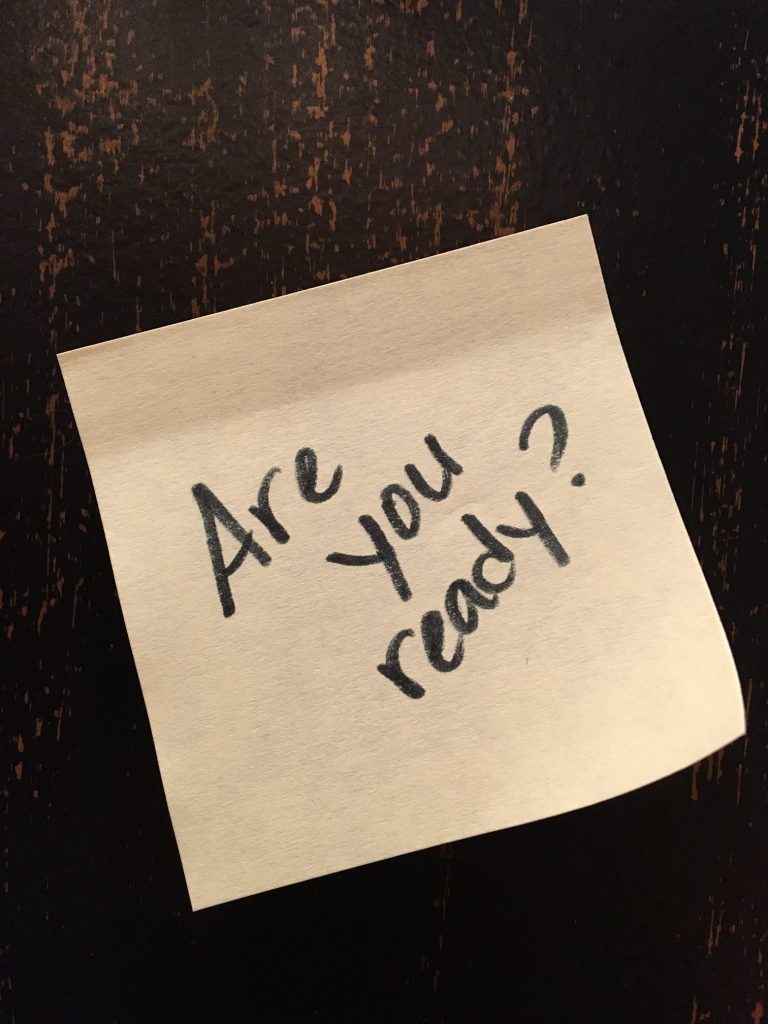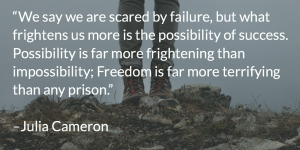
Jun 17, 2016 | Transition & Change

In 2011, the Meyer Foundation and CompassPoint Nonprofit Services produced a research report “Daring to Lead” that surveyed 3,000 nonprofit executive directors and revealed a forecast of significant impending workplace transitions, with 67% of executives reporting that they expect to leave their jobs over the next five years.
Today, while we see many leadership transitions occurring among the Baby Boomer population, “what was once characterized as a pipeline problem can now be described as a bottleneck, as many individuals are choosing to work beyond the traditional retirement age due to a variety of reasons, including a prolonged economic recession,” reports the William and Flora Hewlett Foundation in “Moving Arts Leadership Forward.”
This reality requires organizations to examine its greatest asset – its people, their roles, and career paths – in strategic and creative ways. Workplaces can expect a robust boomer presence through at least 2034, when the youngest boomers will turn 70. This reality impacts Gen X-ers and Millennials aspiring to executive positions, where the wait time for succession is often longer than they would like.
While there was once a question of whether there were enough capable professionals to succeed an organization, now the challenge is more focused on developing and retaining early- and mid-career professionals in an environment of limited opportunities for formal advancement.
Obviously transitions raise a long list of issues that point to the complexity and difficulty of such pivotal moments. While there are no simple solutions, changes in leadership can be addressed positively and proactively and strengthen the organization as a result.
– At a minimum, an organization should have an emergency transition/succession plan if an Executive Director is suddenly unable to perform his or her duties. Many boards of directors are underprepared to handle the transition and selection and support of new leaders, with just 17% reporting that their organizations have a written succession plan (per Daring to Lead 2011).
– Often, nonprofit institutions have a culture of group decision-making – a process that can be complex and create delays. A board can address this issue in its bylaws, empowering a small representative group (executive or personnel committee, for example) to act on its behalf – in situations like this and others.
– Have written job descriptions and a performance evaluation system in place for all staff. This is especially critical for the Executive Director position. Board leadership should have familiarity of the Executive’s core role and functions and how well the individual is performing against agreed upon goals.
– Institute a culture of ongoing cross training among staff, whereby individuals have a clear understanding of one another’s responsibilities – especially among the leadership team.
– If possible, an organization’s key donor relationships should be shared by the Executive Director and other members of the staff and board. This helps lessen vulnerability, share fund raising responsibility, and ensure that vital donor relationships are held with the organization and not exclusively with a particular leader.
– Nonprofit groups often do not have sufficient reserves to weather significant challenges, exposing the organization to financial vulnerabilities. Leadership transitions, if not handled properly, can intensify this situation. However, advanced planning and good management allows even the smallest organizations to build a few months’ operating reserve.
These strategies are critical to developing leaders and preparing for both short- and long-term transitions. In the case of a longer-term planned departure, these actions can be coupled with broader assessment and planning, presenting an organization with a unique opportunity to examine strategic direction, priorities, and chart a future course. The key is not merely to endure transitions, but to emerge stronger and more dynamic from it.
You may also be interested in these related blog posts:
Succession Planning: Conversation Avoided
Challenges to Addressing Leadership Transitions
 About Jeanie Duncan: Jeanie is President of Raven Consulting Group, a business she founded that focuses on organizational change and leadership development in the nonprofit sector. She is a senior consultant for Raffa, a national firm working with nonprofit clients to lead efforts in sustainability and succession planning, executive transition and search. Additionally, Jeanie serves as adjunct faculty for the Center for Creative Leadership, a top-ranked, global provider of executive leadership education.
About Jeanie Duncan: Jeanie is President of Raven Consulting Group, a business she founded that focuses on organizational change and leadership development in the nonprofit sector. She is a senior consultant for Raffa, a national firm working with nonprofit clients to lead efforts in sustainability and succession planning, executive transition and search. Additionally, Jeanie serves as adjunct faculty for the Center for Creative Leadership, a top-ranked, global provider of executive leadership education.
Jan 29, 2012 | Management
When a nonprofit organization experiences a leadership transition, hiring an interim executive director can be the most logical and positive action its board can take.
Leadership change is an increasingly common aspect of nonprofit organizational life. Multiple studies reinforce the impending turnover of top leadership in the nonprofit sector, due in great part to the aging and retiring boomer population. It’s not a matter of if, but when the change is coming. When your organization experiences this transition, research and practice suggests that groups that plan well and use a skilled interim executive director, emerge stronger, more fiscally sound, and with higher levels of optimism about the future impact of their programs and services.
Leadership transition is a period commonly marked with emotion, tension, and stress. Internally, staff and board are in the midst of separating from the previous executive, and the departing director is in an in-between state and can be confused about how much influence he or she wants or should have on the agency’s future. If the director’s departure is forced, emotions may be particularly high.
Externally, some funders, donors, and volunteers will take a “wait and see” approach before becoming involved and investing in the organization. This can create strain between needs and resources, further taxing administrative systems.
A highly skilled interim executive director temporarily takes the helm of an organization, helps the board and staff address important systems and capacity issues, and lays the groundwork for the following leader’s success. This leader:
– Serves as a bridge, giving the board ample time to conduct a thoughtful search process and managing the day-to-day executive responsibilities that include: conducting an objective organizational review, leading anxious staff, reassuring wary funders, and keeping finances and revenue generation on track.
– Tackles unique challenges related to the transition, building on strengths and addressing particular vulnerabilities.
– Helps the board clarify its vision and future leadership needs.
– Models excellence in management and leadership.
– Mentors the new executive director once appointed.
When considering hiring an interim executive director for your organization:
– Begin with the end in mind. Your board should determine what it wants and needs and what is most critical to success over the next few months.
– Identify urgent issues or challenges presently facing your organization.
– Review the current executive director’s job description, determine priorities for the transition period, and draft an Interim job description.
– Seek an interim executive director with solid management experience and a transition skillset. This takes precedence over familiarity with your organization or industry.
– Consider that the assignment is both temporary (four-eight months) and part-time (20 – 25 hours/week) and that the individual should not be a candidate for the full-time position.
– Realize that, due to the unique demands of the role, interim executives are almost always paid higher on an hourly basis than the agency’s permanent executive (although, most interims are part-time and do not receive normal agency benefits).
– Tap local resources for potential candidates, such as area college nonprofit degree programs, consultants serving the nonprofit sector, industry sector affinity groups, and nonprofit consortiums.
There is great power and potential in this “neutral zone” – the space after the former director leaves and the new leader begins. The organization is more open to change than usual and poised to leverage the heightened opportunity. Systems and culture become a bit “unglued” and can be put back together in new and exciting ways that leave the nonprofit stronger and more sustainable.

May 1, 2011 | Career, Transition & Change

For years, I’ve observed athletes, politicians, corporate executives, and colleagues maneuver through their careers advancing, transitioning, or retiring. I’ve admired those who always seemed to know when to make a change, and I’ve often felt frustrated by those who didn’t.
There are those who ride the wave until it crests. They stay in a job, continuing in a role that fits, delivering a great impact and return on their unique investment of creative talent. Then, with the same finesse with which they rode that wave, they ride smoothly to the next wave or opportunity. No matter where they are, their presence and leadership imbues their organizations with energy, enthusiasm, and inspiration – during their tenure and after.
Then there are those who never seem to “know when.” They advance and develop, making great contributions to their enterprise and the people it serves. Some receive numerous accolades for their achievements. Five years pass, then 10, 20, and even beyond, and they stay put. I know that a rare few can continue at the top of their game for extended periods, approaching their work with as much fresh energy, passion, and creativity as ever before. More often than not, however, this isn’t the case.
Staying in one spot for too long leaves them comfortable yet stale, feeling burned out and empty. Their flame went out years ago, and because they don’t “know when” – or more likely they do “know” but hold themselves back with fear and doubt – they engender that same lassitude within their environment and culture.
Over my 20 year career, I’ve always wondered, “How do those who know when, know when?”
It was 2008, and I was in my fifth year as President & CEO of the United Arts Council of Greater Greensboro and my twelfth with the organization overall. I found myself experiencing a sense of restlessness. When I first noticed it, I had no idea what it was or what was causing it; I had never felt anything quite like it before. I knew that above all else, it was persistent. I tried ignoring the sensation, passing it off as a nagging ache and drowning it with my work priorities and busy schedule. But it was like a kid sister continuously tapping on my shoulder.
So, I decided to stop fighting it and instead tuned in to it. I would lie awake at night, tossing and turning, and ask, “What is it? What are you trying to tell me?” I would go for a run, and as the day’s stress melted and my mind freed, I wondered: “Is it something to do with my family? My spouse? Work?” And on it went in my day-to-day activities and thoughts over several months. I’d query, wait, and try to listen.
I wish I could tell you that I had a clear and direct sense of “knowing when” (and knowing what), but it was more a steady growing awareness. Things would happen like meeting new people, having an unexpected outcome with a project, and seeing barriers spring up in one place while opportunities grew in another. Small shifts and events I originally thought to be unrelated and random, when considered in aggregate, were actually pointing me toward a new course.
Accompanying this emotional journey was a more tangible recognition that I had accomplished the major goals I had hoped to achieve for the United Arts Council: debt elimination, significant revenue growth, re-focusing of organizational priorities, creating a new business model, and shoring up board and staff leadership.
Eventually, the two paths intersected, and it became quite clear. I knew what. I knew when. And when was now.
I felt satisfied that I had completed what I had set out to do for the organization. Over those twelve years, I had offered my very best in leadership and service to the organization and its greater mission. The professional experience of leading the organization and its people was the highlight of my career to that point. It simply was time to depart and transition into what would come next…at that point, I had no idea what that would be. But I knew one thing for certain: I didn’t want to follow a traditional career path, moving on to lead another nonprofit arts organization.
 After much reflection and consultation with mentors and a career coach, I determined that the right course for me was to complete my tenure at the Arts Council and then take some time off. Clear my head. Explore some creative pursuits. And allow myself the space and time to renew my energy and shape what would come next. So I committed to a year-long sabbatical, and that journey began in December 2009.
After much reflection and consultation with mentors and a career coach, I determined that the right course for me was to complete my tenure at the Arts Council and then take some time off. Clear my head. Explore some creative pursuits. And allow myself the space and time to renew my energy and shape what would come next. So I committed to a year-long sabbatical, and that journey began in December 2009.
During my sabbatical, I came to believe it’s less about truly “knowing” and more about the courage to tune in to that “knowing,” trust it, and follow it. What prevents most from taking the leap is fear – a doubt in one’s own “personal capital” and self-worth.
Author Julia Cameron, in her book Artist’s Way, wrote that: “We say we are scared by failure, but what frightens us more is the possibility of success. Possibility is far more frightening than impossibility; Freedom is far more terrifying than any prison.”
After spending many years in a particular career or post, it’s easy to slip into the mindset of feeling trapped, but secure. You’re good at what you do, you’ve done it for a long time, and you’re compensated well. It’s natural to want to avoid stirring things up. Change will be challenging, most likely require making tough decisions, moving out of your comfort zone, learning something new, or even beginning a new venture. It’s easier to stick it out – you reason – despite your energy having fallen flat and your passion dimmed.
Possibility, potential, and capacity – tapping into those requires taking a leap of faith. I do recognize that deciding to tune in and take action on “knowing when” requires attention to many variables – timing, financial, family, etc. – all of which have to be considered. But jumping into the unknown is the only way we grow, develop, and realize our potential. If we don’t leap, we’ll never know what could be, or how much happier and more fulfilled we could be.
I am convinced that somewhere along the career track, everyone will experience this sense of “knowing when.” When you do, tune in to it, and take action on your instincts.
- Pay attention to the signs. When you sense burnout, boredom, or restlessness within yourself, move toward it, not away from it. Question why you have these feelings and what you could do to restore enthusiasm, energy, and passion.
- Consult with mentors, advisors, or a coach. An outside-in perspective offers an invaluable process of reflection, goal setting, and charting a course.
- Trust in yourself. If you don’t, no one else will. Inventory your greatest attributes and skills; consider these your key leverage points.
- Take action. If you don’t, how will you ever know “what could have been?” Making a significant change can seem overwhelming. Take the big picture and break it down into smaller pieces. Outline actions to take for each that will advance you closer to your ultimate goal.
 About Jeanie Duncan: Jeanie is President of Raven Consulting Group, a business she founded that focuses on organizational change and leadership development in the nonprofit sector. She is a senior consultant for Raffa, a national firm working with nonprofit clients to lead efforts in sustainability and succession planning, executive transition and search. Additionally, Jeanie serves as adjunct faculty for the Center for Creative Leadership, a top-ranked, global provider of executive leadership education.
About Jeanie Duncan: Jeanie is President of Raven Consulting Group, a business she founded that focuses on organizational change and leadership development in the nonprofit sector. She is a senior consultant for Raffa, a national firm working with nonprofit clients to lead efforts in sustainability and succession planning, executive transition and search. Additionally, Jeanie serves as adjunct faculty for the Center for Creative Leadership, a top-ranked, global provider of executive leadership education.

 About Jeanie Duncan: Jeanie is President of Raven Consulting Group, a business she founded that focuses on organizational change and leadership development in the nonprofit sector. She is a senior consultant for Raffa, a national firm working with nonprofit clients to lead efforts in sustainability and succession planning, executive transition and search. Additionally, Jeanie serves as adjunct faculty for the Center for Creative Leadership, a top-ranked, global provider of executive leadership education.
About Jeanie Duncan: Jeanie is President of Raven Consulting Group, a business she founded that focuses on organizational change and leadership development in the nonprofit sector. She is a senior consultant for Raffa, a national firm working with nonprofit clients to lead efforts in sustainability and succession planning, executive transition and search. Additionally, Jeanie serves as adjunct faculty for the Center for Creative Leadership, a top-ranked, global provider of executive leadership education.




Recent Comments